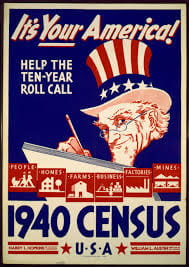
Written by Benjamin Clanton, Government Publications
As you may know, 2020 is a Census year! It is a distinct possibility that many of you have already filled out your Census forms, either through mail or online. In fact, 2020 will be the first time the Census Bureau will ask most people to respond online. But why exactly do we answer these questions sent to us by the federal government? Having an accurate Census is extremely important: it determines representation within Congress for individual states, affects the makeup of the Electoral College, and determines federal funding for countless programs and organizations. The history of the U.S. Census is actually quite complicated and reflects the story of our nation’s progress. The Census has even balanced on the cutting edge of data collection and tabulation for most of its existence, something that we experience every day in all parts of life.
Beginnings
The simple counting of people that live within the United States, along with the gathering of more detailed information on the population and the country itself, has been a mandate of the federal government since its inception. Article I, Section 2, Clause 3 of the U.S. Constitution outlined how representation in Congress would be determined and called for the ‘enumeration’ of the nation’s people every 10 years. Thus, in 1790, the first Census was held, asking only six questions, which have grown in number and variety during the two centuries since. It was handled by the State Department under the guidance of then Secretary of State Thomas Jefferson. The actual gathering of data was overseen by U.S. Marshals, who hired 650 assistants to cover their respective districts; Marshals continued with this duty until 1879, when the responsibility was handed over to professional enumerators due to concerns over accuracy.
Changes Over Time
The Census has certainly never been a static part of American governance. In 1849, the Department of the Interior took responsibility for holding the 1850 Census, which would be the first to count the population of California as part of the United States. Further changes came over the next 75 years; in 1902, the U.S. Census Bureau became a permanent agency within the Department of Commerce and Labor, ultimately remaining as part of Commerce when it became an independent department in 1913.
Perhaps the most interesting aspect of the Census has been how the collection of data progressed over the years. As mentioned earlier, U.S. assistant Marshals went door-to-door asking questions, often in rugged rural areas. The tabulation of this information was a painstaking operation that often took years. In the late nineteenth century, Herman Hollerith, a former Census employee, created an electric tabulation machine that used punch cards to quickly process data. In the mid-twentieth century, the Census Bureau received UNIVAC I, the first nonmilitary computer, to further help tabulate data covering the exploding American population. As the Census begins to move online, new ways of gathering and storing information are certainly on the horizon for 2030 and beyond.
Census Fun Facts!
- New York City has always been listed as the most populous city in the nation. In 1790, the first Census, its population was just over 33,000. In 2010, it was at almost 8.2 million
- The most populous State at the time of the first Census was Virginia, with just over 747 thousand people. The winner in 2010: California, which did not gain statehood until 1850, tallying in at just over 37 million.
- Worried about your data becoming public? By law, Census records aren’t released to the public by the National Archives until 72 years after Census Day, which was on April 1. If you are counting, that will be in the distant future of 2092 for the 2020 edition.








 For those planning to use
For those planning to use 